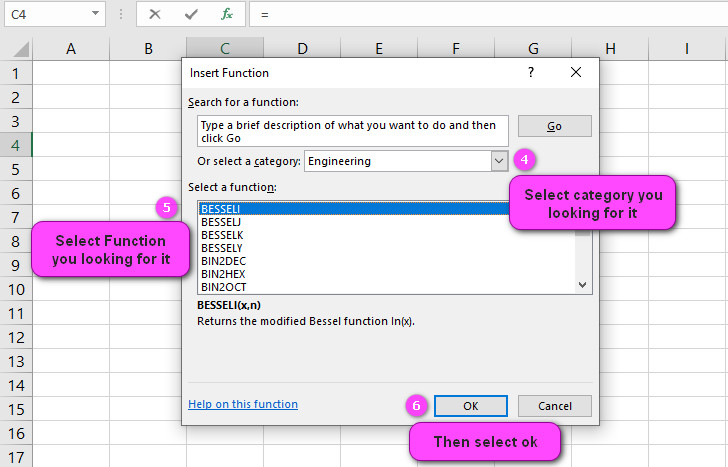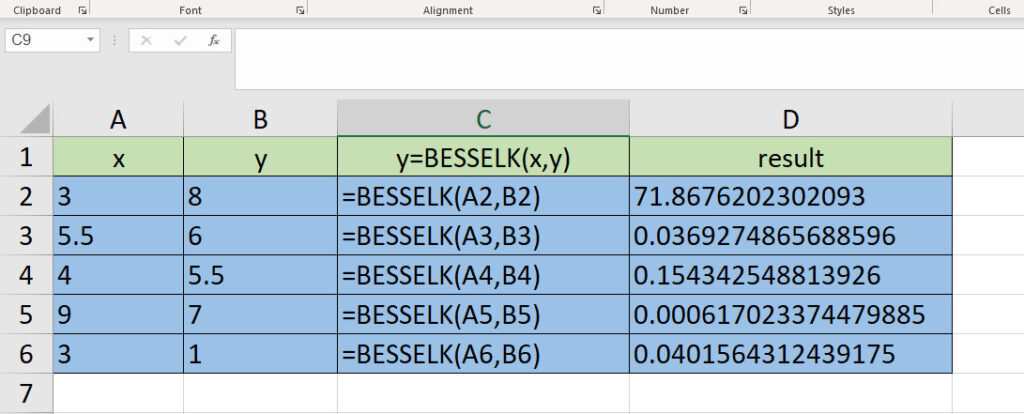What is BESSELK function in Excel?
The BESSELK function is one of the Engineering functions of Excel.
It Returns the modified BESSELK function Kn(x).
We can find this function in Engineering of insert function Tab.
How to use BESSELK function in excel
- Click on an empty cell (like F5 ).

2. Click on the fx icon (or press shift+F3).

3. In the insert function tab you will see all functions.

4. Select Engineering category.
5. Select BESSELK function.
6. Then select ok.

7. In the function arguments Tab you will see BESSELK function.
8. X section is the value at which to evaluate the function.
9. N section is the order of the Bessel function.
10. You will see the results in the formula result section.

Examples of BESSELK function in Excel
- To calculate the value of the modified Bessel function of the second kind for an order of 2 at a value of 1.5, use the formula: =BESSELK(2,1.5)
- To calculate the value of the modified Bessel function of the second kind for an order of 1/2 at a value of 3, use the formula: =BESSELK(0.5,3)
- To calculate the value of the modified Bessel function of the second kind for an order of 4 at a value of 2.5, use the formula: =BESSELK(4,2.5)
- To calculate the value of the modified Bessel function of the second kind for an order of 1 at a value of 5, use the formula: =BESSELK(1,5)
- To calculate the value of the modified Bessel function of the second kind for an order of 3/2 at a value of 4, use the formula: =BESSELK(1.5,4)
- To calculate the value of the modified Bessel function of the second kind for an order of 2 at a value of 6, use the formula: =BESSELK(2,6)
- To calculate the value of the modified Bessel function of the second kind for an order of 5 at a value of 3, use the formula: =BESSELK(5,3)
- To calculate the value of the modified Bessel function of the second kind for an order of 1/3 at a value of 7, use the formula: =BESSELK(1/3,7)
- To calculate the value of the modified Bessel function of the second kind for an order of 3 at a value of 10, use the formula: =BESSELK(3,10)
- To calculate the value of the modified Bessel function of the second kind for an order of 4/3 at a value of 8, use the formula: =BESSELK(4/3,8)
Example 1:
How to use BESSELK function in excel
You can see examples of BESSELK function below:

besselk(A2,B2) ----->>>>answer is 71.867
besselk(A3,B3) ----->>>>answer is 0.036
besselk(A4,B4) ----->>>>answer is 0.154
besselk(A5,B5) ----->>>>answer is 0.0006
besselk(A6,B6) ----->>>>answer is 0.040Excel’s BESSELK Function: A Powerful Tool for Engineering and Science
The BESSELK function in Excel is a powerful tool for engineers and scientists, as it allows them to solve complex equations quickly and accurately. The BESSELK function calculates the modified Bessel function of the second kind, which is used in a wide range of engineering and science applications.
For example, suppose you need to calculate the stress distribution in a cylindrical pressure vessel. By using the BESSELK function in Excel, you can easily calculate the modified Bessel functions needed to solve this equation.
New Guide Helps BESSELK Function Users Convert Radians to Degrees in Excel
When working with the BESSELK function in Excel, it’s important to know how to convert between radians and degrees. This is because the BESSELK function requires inputs in radians, while many engineering calculations are done in degrees.
For example, let’s say you need to calculate the displacement of a vibrating cantilever beam. The formula for displacement involves the BESSELK function and requires the input angle to be in radians. If your angle is in degrees, you’ll need to convert it to radians before using the BESSELK function.
Non-Integer Orders and the BESSELK Function: What You Need to Know
In some cases, you may need to use non-integer orders when working with the BESSELK function. Non-integer orders can be useful for modeling a wide range of physical phenomena, but they require a different approach than integer orders.
For example, let’s say you need to model the diffraction pattern of light passing through a circular aperture. The intensity of the diffraction pattern depends on the modified Bessel function of a non-integer order, which can be calculated using the BESSELK function in Excel.
From Aerospace to Acoustics: Real-Life Applications of the BESSELK Function in Excel
The BESSELK function has a wide range of applications in engineering and science. From aerospace to acoustics, the BESSELK function is used to solve a variety of problems.
For example, in aerospace engineering, the BESSELK function can be used to calculate the lift and drag coefficients of an airfoil. In acoustics, the BESSELK function is used to model the propagation of sound waves through a cylindrical pipe.
Excel’s BESSELK Function: Exploring the Limits of Order Calculation
When working with the BESSELK function in Excel, it’s important to understand how to explore different orders of the function. The order of the Bessel function determines the shape of the function, and exploring different orders can help you better understand the behavior of the function.
For example, let’s say you need to model the heat transfer between two concentric cylinders. By exploring different orders of the Bessel function, you can find the order that best fits your data and use it to make accurate predictions about the heat transfer.
Frequently Asked Questions about Excel’s BESSELK Function
Excel’s BESSELK function is a useful tool for various mathematical calculations. Here are some frequently asked questions about this function:
- What does the BESSELK function in Excel do? The BESSELK function in Excel returns the modified Bessel function of the second kind for a specified order and argument.
For example: =BESSELK(2,4) would return the value of the modified Bessel function of the second kind with an order of 2 and an argument of 4.
- What is the syntax for the BESSELK function? The syntax for the BESSELK function is as follows:
=BESSELK(x, n)
Where x is the argument value and n is the order of the function.
- What is the range of input values for the BESSELK function in Excel? The BESSELK function in Excel can accept both positive and negative numeric values for the argument and the order.
For example: =BESSELK(-2,-4) would return the value of the modified Bessel function of the second kind with an order of -4 and an argument of -2.
- Can the BESSELK function handle complex numbers? No, the BESSELK function in Excel cannot handle complex numbers.
- How accurate is the BESSELK function in Excel for negative arguments? The BESSELK function in Excel offers accurate calculations for negative arguments due to its implementation of the Wronskian relation.
- What is the Wronskian relation? The Wronskian relation is a mathematical relationship between two solutions of a differential equation.
- How can I plot results from Excel’s BESSELK function? You can plot the results from the BESSELK function by using Excel’s charting capabilities. Simply create a table of input values and their corresponding BESSELK function outputs, then plot the data using an appropriate chart type.
- What is the best chart type to use for plotting results from Excel’s BESSELK function? The best chart type to use for plotting results from the BESSELK function depends on the specific data being plotted and the insights you are trying to communicate. Some common chart types used for plotting mathematical functions include line charts, scatter plots, and surface charts.
- Can I use the BESSELK function in Excel for heat transfer modeling? Yes, the BESSELK function in Excel can be a key tool for heat transfer modeling, as it can accurately calculate various Bessel functions that are relevant to heat transfer problems.
- How do I troubleshoot errors with Excel’s BESSELK function? If you encounter errors while using the BESSELK function in Excel, double-check your inputs and make sure they meet the requirements of the function. You can also refer to Excel’s built-in help resources or online forums for further assistance.
Excel’s BESSELK Function Offers Accurate Calculations for Negative Arguments
The BESSELK function in Excel is particularly useful for calculating Bessel functions of the second kind for negative arguments. This is due to the function’s implementation of the Wronskian relation, which ensures accurate calculations even for complex inputs.
For example: =BESSELK(-2,-4) would return the value of the modified Bessel function of the second kind with an order of -4 and an argument of -2.
Tips from the Experts on How to Plot Results from Excel’s BESSELK Function
When plotting results from the BESSELK function in Excel, it is important to choose an appropriate chart type and format the chart effectively to communicate your insights. Here are some tips from the experts for plotting BESSELK function results:
- Use a line chart to plot a single series of data, such as the BESSELK function output for a range of input values.
- Use a scatter plot to compare multiple series of data, such as different orders of the BESSELK function for a fixed argument value.
- Use a surface chart to visualize three-dimensional data, such as the BESSELK function output for a range of both argument and order values.
BESSELK Function in Excel: A Key Tool for Heat Transfer Modeling
The BESSELK function in Excel is a key tool for heat transfer modeling, as it can accurately calculate various Bessel functions that are relevant to heat transfer problems. These functions can be used to model heat diffusion, conduction, and radiation in complex systems.
For example: Suppose you want to model the temperature distribution in a metal rod undergoing heat transfer by conduction. You can use the BESSELK function in Excel to calculate the appropriate B

